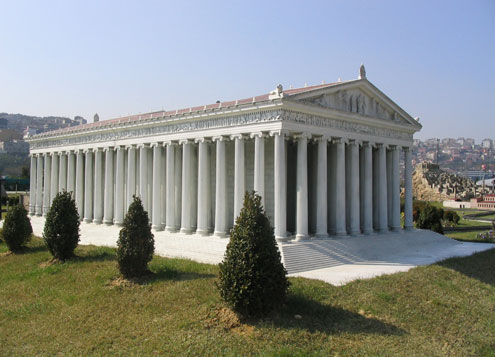
The original list inspired many different versions through the ages, usually sticking to only seven entries. Undoubtedly this is due to the special significance attached to the number seven. In the literature of Mesopotamia seven was the number of gates to the Underworld, it was seven Sages who brought the arts of civilization to mankind, and there were seven Celestial Bodies (the sun, moon, and five major planets) whose movements and conjunctions affected the fate of individuals, cities, and nations. In myths and legends demons were prone to show up seven at a time. Many actions in rituals and magic had to be repeated seven times.
Of the original Seven Wonders, only one—the Great Pyramid of Giza, the oldest of the ancient wonders—remains relatively intact. The Colossus of Rhodes, the Lighthouse of Alexandria, the Mausoleum at Halicarnassus, the Temple of Artemis and the Statue of Zeus have all been destroyed. The location and ultimate fate of the Hanging Gardens of Babylon was until very recently a great mystery.

Before commenting further on the wonders, I want to suggest a reason for compiling a bucket list more than 2000 years ago. It began with Alexander the Great. Born in 356 BC, he succeeded his father Philip II to the throne at the age of twenty. Most of his ruling years were spent on an unprecedented military campaign through Asia and northeast Africa, and he created one of the largest empires of the ancient world by the age of thirty, stretching from Greece to northwestern India. Since Greeks ruled much of the known western world by the 4th century BC, it made sense for their travelers to compile a list of “wonders” in the sense of exceptional sights, not to be missed.
1. The Great Pyramid, also known as the Pyramid of Cheops, is the oldest and largest of the three pyramids in the Giza pyramid complex of Egypt. It is also the oldest of the Seven Wonders of the Ancient World, having been built as a tomb for the Pharaoh Khufu over a 20-year period concluding around 2560 BC. Because of its size, building the pyramid in 20 years required installing approximately 800 tons of stone every day.
2. The Colossus of Rhodes was a statue of the Greek god of the sun Helios, erected in the city of Rhodes, in 280 BC. According to most contemporary descriptions, the Colossus stood approximately 33 meters (108 feet) high—the approximate height of the modern Statue of Liberty from feet to crown—making it the tallest statue of the ancient world.
3. The Lighthouse at Alexandria, built between 280 and 247 BC, has been estimated to be 100 meters in overall height. For many centuries it was one of the tallest man-made structures in the world.
4. The Mausoleum at Halicarnassus was a tomb built between 353 and 350 BC. As designed by Greek architects, it was approximately 45 meters in height, and the four sides were adorned with sculptural reliefs, each created by one of four famed Greek sculptors. Because of this magnificent tomb, the word mausoleum has now come to be used generically for an above-ground burial structure.
5. The Temple of Artemis (also known as Diana), located at Ephesus (in present-day Turkey), was a Greek temple dedicated to worship of the goddess. Completely rebuilt three times, in its final form the temple was praised extravagantly for its beauty.
6. The Statue of Zeus was a giant seated figure, about 13 meters tall, completed around 435 BC at the sanctuary of Olympia in Greece. A sculpture of ivory plates and gold panels over a wooden framework, it represented the god sitting on an elaborate cedar wood throne ornamented with ebony, ivory, gold and precious stones.
7. The Hanging Gardens were described as a remarkable feat of engineering with an ascending series of tiered gardens containing a wide variety of trees, shrubs, and vines. From a distance it was said to resemble a large green mountain. Their location was a mystery until recent archeological work determined that they were built at Nineveh, not Babylon. Sustaining the gardens required an aqueduct to transport water from distant mountains and complex machinery to lift it.
Unfortunately, only one of these wonders can be found and visited today, and it is the oldest of them: the Great Pyramid of Giza in Egypt. Perhaps you should add it to your bucket list.
Jerry Lincecum is a retired Austin College professor who now teaches older adults to write their autobiographies and family histories. Email him at jlincecum@me.com.